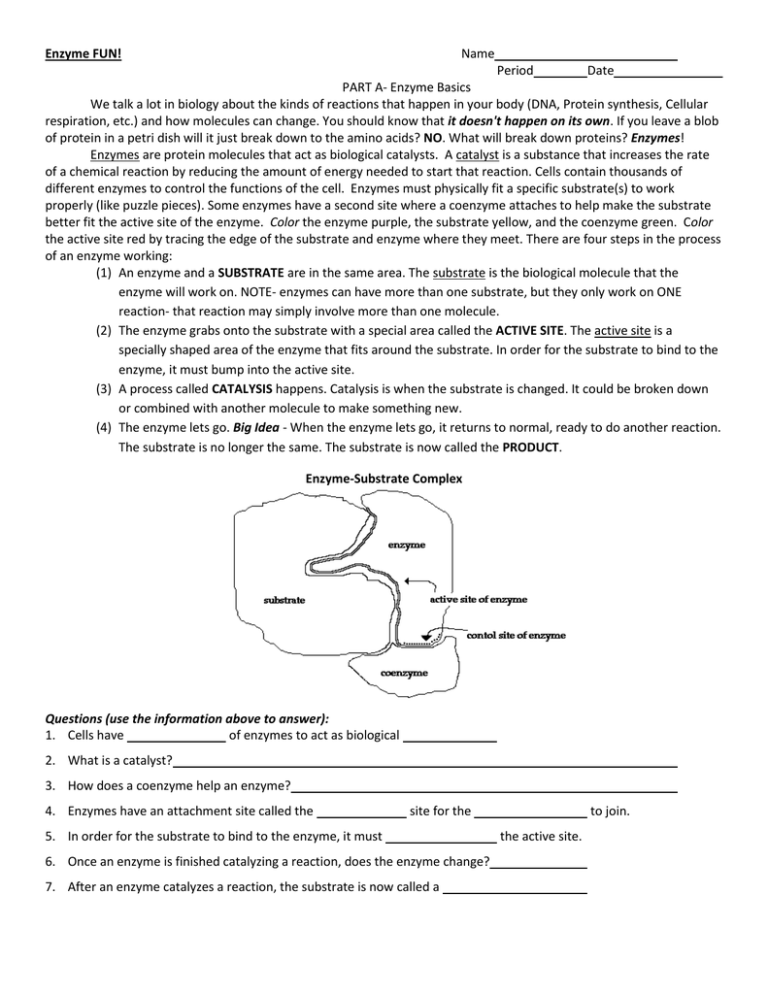Enzymes worksheet
advertisement

Enzyme FUN! Name Period Date PART A- Enzyme Basics We talk a lot in biology about the kinds of reactions that happen in your body (DNA, Protein synthesis, Cellular respiration, etc.) and how molecules can change. You should know that it doesn't happen on its own. If you leave a blob of protein in a petri dish will it just break down to the amino acids? NO. What will break down proteins? Enzymes! Enzymes are protein molecules that act as biological catalysts. A catalyst is a substance that increases the rate of a chemical reaction by reducing the amount of energy needed to start that reaction. Cells contain thousands of different enzymes to control the functions of the cell. Enzymes must physically fit a specific substrate(s) to work properly (like puzzle pieces). Some enzymes have a second site where a coenzyme attaches to help make the substrate better fit the active site of the enzyme. Color the enzyme purple, the substrate yellow, and the coenzyme green. Color the active site red by tracing the edge of the substrate and enzyme where they meet. There are four steps in the process of an enzyme working: (1) An enzyme and a SUBSTRATE are in the same area. The substrate is the biological molecule that the enzyme will work on. NOTE- enzymes can have more than one substrate, but they only work on ONE reaction- that reaction may simply involve more than one molecule. (2) The enzyme grabs onto the substrate with a special area called the ACTIVE SITE. The active site is a specially shaped area of the enzyme that fits around the substrate. In order for the substrate to bind to the enzyme, it must bump into the active site. (3) A process called CATALYSIS happens. Catalysis is when the substrate is changed. It could be broken down or combined with another molecule to make something new. (4) The enzyme lets go. Big Idea - When the enzyme lets go, it returns to normal, ready to do another reaction. The substrate is no longer the same. The substrate is now called the PRODUCT. Enzyme-Substrate Complex Questions (use the information above to answer): 1. Cells have of enzymes to act as biological 2. What is a catalyst? 3. How does a coenzyme help an enzyme? 4. Enzymes have an attachment site called the site for the 5. In order for the substrate to bind to the enzyme, it must 6. Once an enzyme is finished catalyzing a reaction, does the enzyme change? 7. After an enzyme catalyzes a reaction, the substrate is now called a to join. the active site. PART B- Changing Enzymes In general, enzymes are protein molecules which must be folded in a specific three-dimensional shape in order to function properly. Excess heat, a change in pH from neutral, etc. change the shape of enzymes and their active sites so the enzyme is unable to work. If an enzyme's shape changes significantly and it can no longer function, the enzyme is said to have become denatured. Once an enzyme has been denatured, it can no longer perform its job and the process is NOT reversible. The enzyme pancreatic amylase is manufactured and secreted by the pancreas into the small intestine. Pancreatic amylase breaks down starch into maltose, a disaccharide. Pepsin is an enzyme that is released by the cells of the stomach and functions in the stomach to break down proteins into smaller polypeptide units. The following graphs show the activities of various enzymes under various environmental conditions. Remember, different enzymes function best at different pHs and temperatures, depending on the environment that they work in. For example, enzymes in your blood work best at a pH around 7 because that is the pH of your blood, but enzymes in your stomach work best at a pH around 2-3, because that is the pH within your stomach. For the graph, enzyme activity means how well or fast the enzyme is working, so the taller the line, the better the enzyme is functioning. Notice on Figure 2 that when an enzyme becomes denatured due to high temperatures, the activity rapidly declines. Questions (use the information and graphs above to answer): 8. What can change the shape of an enzyme? 9. What does denatured mean? 10. Is denaturing reversible? 11. What is the function of pancreatic amylase? 12. What is the function of pepsin? 13. Optimum pH is the temperature at which something functions BEST. What is the optimum pH for pepsin? 14. What is the optimum pH for pancreatic amylase? 15. At which pHs would pepsin be denatured (there are two answers)? 16. At which pHs would pancreatic amylase be denatured (there are two answers)? 17. What would happen to pancreatic amylase in your stomach? 18. Trypsin is a protein digesting enzyme that functions in the small intestine. What do you think would be the optimum pH for trypsin? 19. Optimum temperature is the temperature at which something functions BEST. What is the optimum temperature for Enzyme A? Enzyme B? 20. At which temperature is Enzyme A denatured? Enzyme C? Enzyme B? Enzyme C? 21. Which enzyme would be most likely to be found in a bug that lives in Antarctica? (A, B, or C) 22. Which enzyme would be most likely to be found in a human (average body temp = 37oC)? (A, B, or C)


